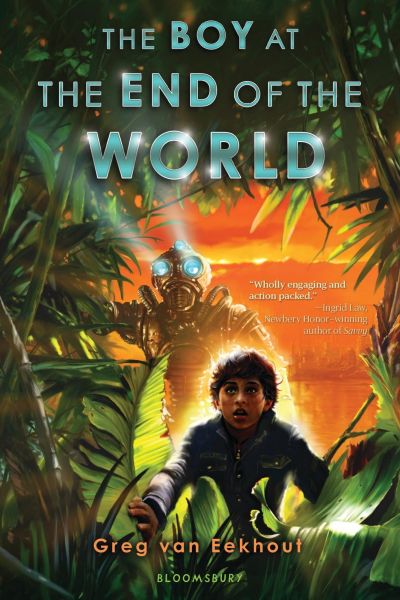Babe in the Woods
The Boy at the End of The World
By Greg van Eekhout

12 Apr, 2021
Greg Van Eekhout’s 2011 The Boy at the End of The World is a standalone post-apocalyptic adventure.
Fisher is decanted into a high-tech ark under attack. He’s a newborn in the body of an adolescent boy. He manages to escape the facility before it is destroyed. The good news: Fisher was imbued with a suite of skills before being decanted and he is accompanied by a helpful robot named Click. The bad news: his skills are not applicable to current circumstances and Click is broken.
His new world presents him a whole series of exciting discoveries. For one thing, Fisher is no apex predator. He is in fact very far down this world’s food chain.
Click helpfully provides backstory. Faced with a world lurching towards disaster, scientists created an Ark that would preserve the soon-to-be-lost species of the world. Robots like Click guarded the Ark against calamity. When conditions were right, they would recreate and release animals to repopulate the world. But something has gone very wrong.
Fisher was sent to be part of a community of pioneers. He is instead the only human to escape the Ark, which makes his focus on watercraft and fishing a crippling specialization. Click was damaged in the attack and has lost access to important data.
Founding a new human race all by himself can’t work. Therefore, Fisher must find more humans. Contrary to the expectations of the ark builders, some humans did survive the calamity (though whether they can continue to do so is unclear). There may also be more arks. Fisher and Click set out in quest of more humans in a world much transformed, where other species rule and humans are, if careless, a snack.
It’s a world where what was planned to be humanity’s greatest hope may be its worst nightmare.
~oOo~
The heretofore unmentioned adorable mammoth Protein survives and accompanies our protagonist. A cute animal companion such as frequently feature in SFF. At least it’s not a cat.
Huh. Second book in my recent reading to feature dodging climate change by essentially sleeping through the disaster. In this case, however, the designers did not themselves directly benefit. They got to stay outside with everyone else.
I found it interesting that the novel never makes a particularly convincing case that humans should be restored. Not only did they cause the great calamities that wracked the Earth through their own short-sightedness, but they created successor species that seem to fill the intelligent tool user niche better than we did. Nevertheless, as we’re all human here (or so I assume), we can forgive Fisher for wanting to unleash more of our kind on a long-suffering world.
Unsurprisingly in a novel about surviving the unintended consequences of the industrial revolution, there were unintended consequences of the methods used to survive. Some of the robots guarding the arks are roving killbots that were intended to prevent any desperate human survivors from commandeering the ark. Fisher’s Ark released killbots. Other arks released worse. Bad luck for any humans who come too close. Bad luck for Fisher. But at least it worked out better than Poul Anderson’s 1962 short story “Epilog.” Thus far.
If I were going to compare this book to other books I’ve read, I’d say that this is one part Mutant Year Zero to one part Kamandi, the Last Boy on Earth. Not that that helps my readers all that much, since you’re unlikely to have read those books. Fisher’s world is more hospitable than the world of Mutant Year Zero, and the new intelligences he encounters are considerably nicer than the ones that Kamandi meets (well, mostly). The adventure that results is engaging and thought-provoking. And the mammoth survives.
The Boy at the End Of The World is available here (Amazon US), here (Amazon Canada), here (Amazon UK), here (Barnes & Noble), here (Book Depository), and here (Chapters-Indigo).
